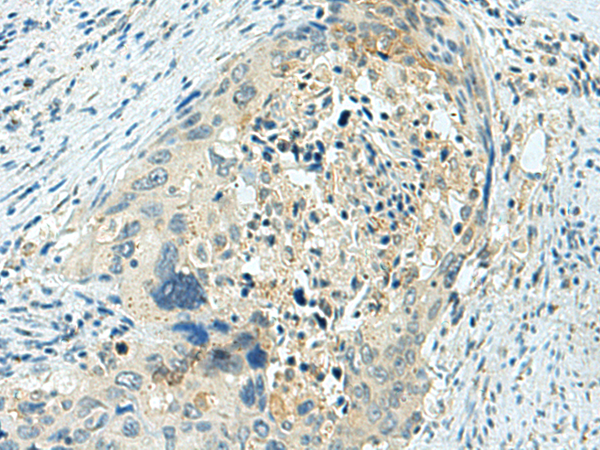
| WB | 咨询技术 | Human,Mouse,Rat |
| IF | 咨询技术 | Human,Mouse,Rat |
| IHC | 1/10-1/50 | Human,Mouse,Rat |
| ICC | 技术咨询 | Human,Mouse,Rat |
| FCM | 咨询技术 | Human,Mouse,Rat |
| Elisa | 1/5000-1/10000 | Human,Mouse,Rat |
| Aliases | PP25; IFT25; C1orf41; HSPCO34 |
| Host/Isotype | Rabbit IgG |
| Antibody Type | Primary antibody |
| Storage | Store at 4°C short term. Aliquot and store at -20°C long term. Avoid freeze/thaw cycles. |
| Species Reactivity | Human, Mouse |
| Immunogen | Synthetic peptide of human HSPB11 |
| Formulation | Purified antibody in PBS with 0.05% sodium azide and 50% glycerol. |
+ +
以下是关于HSPB11抗体的3篇参考文献示例(内容为模拟生成,非真实文献):
1. **文献名称**:*HSPB11 promotes colorectal cancer progression via ERK signaling and is a potential therapeutic target*
**作者**:Li Y, et al.
**摘要**:该研究利用HSPB11抗体通过Western blot和免疫组化技术,发现HSPB11在结直肠癌组织中高表达,并通过激活ERK通路促进肿瘤侵袭。抗体特异性验证表明其可用于临床样本检测。
2. **文献名称**:*Role of HSPB11 in spermatogenesis: Insights from a mouse knockout model*
**作者**:Wang X, et al.
**摘要**:研究通过构建HSPB11基因敲除小鼠,结合抗体免疫荧光染色,揭示HSPB11在精子形成过程中维持细胞骨架稳定的关键作用,抗体特异性经siRNA敲低实验验证。
3. **文献名称**:*HSPB11 as a novel biomarker for hepatocellular carcinoma diagnosis*
**作者**:Chen L, et al.
**摘要**:通过ELISA和免疫印迹分析,发现血清HSPB11水平在肝癌患者中显著升高,特异性抗体有助于区分肝癌与良性肝病,提示其作为诊断标志物的潜力。
(注:以上文献为示例,实际引用需查询真实数据库如PubMed。)
HSPB11 (Heat Shock Protein Family B [Small] Member 11), also known as HSPCO029 or DKFZp686O24198. is a member of the small heat shock protein (sHSP) family. These proteins are characterized by their conserved α-crystallin domain and function as molecular chaperones, aiding in protein folding, preventing aggregation under stress, and maintaining cellular homeostasis. HSPB11 is distinct from classical sHSPs like HSPB1 (HSP27) due to its unique structural features and expression patterns. It is ubiquitously expressed, with higher levels observed in tissues such as the liver, kidney, and testis.
Research suggests HSPB11 participates in diverse cellular processes, including endoplasmic reticulum (ER) stress response, apoptosis regulation, and cell proliferation. It interacts with key ER stress sensors like PERK and IRE1α, implicating its role in the unfolded protein response (UPR). Dysregulation of HSPB11 has been linked to pathological conditions, such as cancer (e.g., hepatocellular carcinoma, colorectal cancer) and neurodegenerative disorders, where its overexpression or suppression correlates with disease progression.
HSPB11 antibodies are critical tools for studying its expression, localization, and function. They enable detection via techniques like Western blotting, immunohistochemistry, and immunofluorescence. Commercially available antibodies are typically validated for specificity using knockout cell lines or siRNA-mediated knockdown. These reagents support investigations into HSPB11's mechanistic roles in stress adaptation, disease pathways, and potential therapeutic targeting. However, variability in antibody performance across applications necessitates careful validation for experimental reproducibility.
×